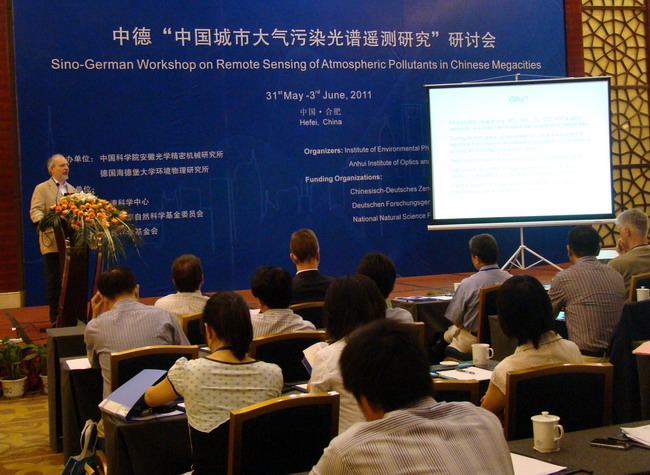HEFEI, China – The Anhui Institute of Optics and Fine Mechanics (AIOFM), Chinese Academy of Sciences (CAS), in cooperation with the Institute of Environmental Physics (IUP), University of Heidelberg, Germany, held the ‘Sino-German Workshop on Remote Sensing of Atmospheric Pollutants in Chinese Megacities’ from May 31st through June 3rd, 2011. The workshop was sponsored by Sino-German Center. Prof. Miaogen Zhao, German associate director of the Sino-German Center, attended the workshop and summarised the objectives and the funding programmes of the Sino-German Society in an introductory presentation. Professor Ulrich Platt, director of the IUP, and Professor Wenqing Liu, director of the AIOFM, shared the chairman duty and addressed the workshop.
Air pollution becomes a major environmental problem in Chinese megacities. Increasing emission and transport of air pollutants not only impair the air quality, but also cause regional climatic oscillations. Spectroscopic remote sensing technologies are well established methods for measuring atmospheric trace gases. In particular, the method of Differential Optical Absorption Spectroscopy (DOAS) has been developed rapidly in recent years, especially for measuring vertical column densities and vertical profiles of tropospheric pollutants and aerosols. DOAS is widely used on various platforms such as ground stations, ships, airplanes and satellites.
The workshop brought together over 40 technology leaders and research experts from Germany and China, representing at least 17 departments, universities and institutes including: Anhui Institute of Optics and Fine Mechanics, CAS, Institute of Atmospheric Physics, CAS, Institute of Remote Sensing Applications, CAS, Beijing University, Fudan University, University of Science and Technology of China, Sun Yat-sen University, Beijing Institute of Technology, Wuhan University, National Satellite Meteorological Center, Ministry of Environmental Protection, University of Heidelberg, Max Planck Institute for Chemistry, University of Bremen, Karlsruhe Institute of Technology, German Aerospace Center, and Belgium Institute for Space Aeronomy.
The workshop offered a valuable opportunity and effective platform to share the advances Chinese and German scientists had made at the local, national and international levels. Experts from China and Germany discussed the latest update on research of remote sensing of tropospheric trace gases in urban areas, recent progress in the method of Differential Optical Absorption Spectroscopy technology, as well as related measurement techniques for studying atmospheric pollutants and aerosols in megacities. The workshop provided a vision of the long-term opportunities and benefits of innovation technologies, with the focus of the presentations and subsequent discussions on remote sensing of atmospheric pollutants by DOAS, atmospheric physics and environment characteristics in megacities, complex chemical processes in polluted air, satellite remote sensing, as well as photochemical model calculations on air quality.
The workshop concluded with a visit of the Environmental Optics Center of AIOFM, which is also the Key Laboratory of Environmental Optics and Technology of CAS. This center is known as State Environmental Protection Key Laboratory of Optical Monitoring Technology of China as well. This tour provided detailed information on the technological developments in the field of atmospheric remote sensing at AIOFM.
The workshop allowed to establish shared goals, priorities, and strategies., Perspectives for future collaborations between Chinese and German research groups were discussed in detail, in particular in view of future measurement campaigns for the investigation of atmospheric trace gases and aerosols in Chinese megacities, as well as a joint intercomparison campaign with the aim of harmonising measurement techniques and data analyses.
